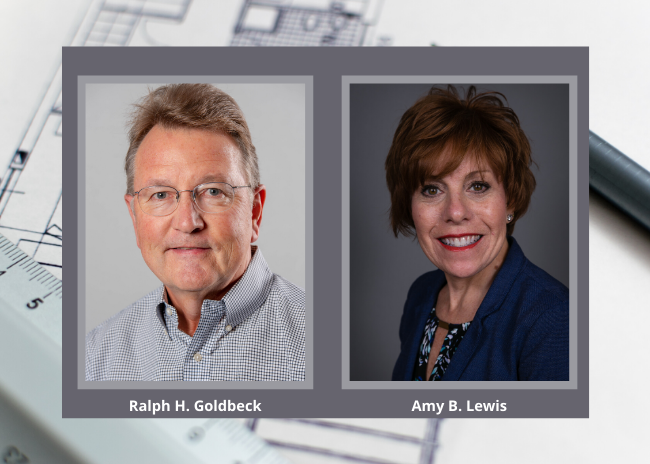Traditional disaster preparedness involves creating a plan for when chaos strikes, whether it’s brought forth by Mother Nature or manmade. As COVID-19 continues to shape our world, we talked with two experts in disaster planning in the foodservice industry.
Ralph H. Goldbeck AIA is an owner/partner of Kitchens To Go built by Carlin. He is a registered architect with over 40 years in the foodservice industry and is currently Chair of the Fresno Citizen Corps Council and former Board Chair of the Central California American Red Cross. Goldbeck is active in many industry associations and is currently Industry Advisory Board chair for the Association for Healthcare Foodservice.
Amy B. Lewis, MBA, is the director of marketing and business development for Kitchens To Go built by Carlin. She has over 30 years in the foodservice industry with wide-ranging expertise in sales, marketing, brand management, new business development, and leadership. She is a member of numerous industry boards and committees and presents regularly on the topic of disaster preparedness in foodservice.
In this Q&A, they discuss what they’ve learned in the arena of disaster preparedness, how it applies to this moment, and what they’re seeing in the foodservice marketplace right now.
I know you have a long background in disaster preparedness and recovery. How is the global pandemic different — or not — from your past experiences?
RG: It is different. This is more like a world war than a typical disaster. Like with Hurricane Katrina or even 9/11, the impact was localized, or we dealt with it as a country. This is a world event. When you have a disaster, something bad happens and you come in and pick up the pieces. You deal with the immediate cleanup, then you deal with the recovery, and then it’s over. In this situation, it’s not an immediate event, it has a long-term impact and the recovery is even longer. There may not be a recovery from this in some sense. The normal will move to what will be a new normal. So, this is a very unique situation.
AL: I’ve spent hours during the pandemic on webinars and listening to different broadcasts. What’s different about this is that people keep saying they planned for a disaster, but they’ve never done pandemic planning. I mean, I don’t think anybody truly thought this would happen. The other, positive side is that there’s a great opportunity for innovation, which will look very different from what would happen in a traditional disaster. If it’s a flood, a fire, a hurricane, you go back to business as usual as the goal. Nobody can do that now. There’s a whole new lingo that’s cropped up now with “physical distancing”, “flattening the curve”, “community containment” and creating “outposts”, for instance, as colleges and universities look at what to do so they can feed students safely. They need to “de-densify,” and I believe there’s a lot of opportunity in both the commercial and noncommercial segments as people move past analysis paralysis. People in every segment have been talking about and considering the same things over and over and over. Now is the time to look forward. It’s time to look at your operation and think about what you can do differently moving forward to help get customers back. The innovative spirit that humans have is different in this situation than it would be in a regular disaster.
What do you think is most applicable to this moment in terms of your experience in disaster recovery?
AL: Communication and transparency. I was on a NACUFS (National Association of College and University Foodservices) call recently, and they talked about pulling together foodservice and auxiliary services and even residential services — and they were all working together. Now is the time to look at teamwork and identify those areas that needed to be shored up a bit.
Obviously, sanitation is huge, but it’s really about transparency for everybody. What steps is the restaurant taking to ensure its staff and overall operation are safe and what are they doing to ensure customers can come and dine and don’t leave infected? And what signage or other cues, like sanitation stations, are in place to let patrons know what the operator is doing? It can’t be behind doors. You have to have it out front.
RG: When you have a normal disaster, something is left broken. The problem with this is that nothing is broken. Everything is there. You just can’t use it. So, people aren’t used to that. As Amy mentioned, a lot of disaster planning is written around typical disasters but not a pandemic.
What are you seeing trending? And what’s keeping you busy?
RG: We’re seeing a postponement of certain things — plans are being postponed to deal with the unplanned. People are looking for nontraditional solutions because this is such a strange time The supply chain has been interrupted and will continue to be interrupted. That’s going to continue to happen. I was on the phone recently with a supplier that ships nut products and other items internationally, and they’ve had a hard time getting their products through ports. People will have to continue to plan around supply chain interruptions.
As for trends, I know the quick-serve segments are doing well. Pizza is doing well. Wing Stop is doing record numbers because the chain provides a takeaway food. At one point, drive-thrus were being shut down and now they can’t open them quickly enough. Places are adding drive-thrus to stay in business. We’ll continue to see more of that.
Starbucks has been so popular over the years because the chain created a third space where people spend many hours, but they can’t do that any longer. Drive-thrus are a more efficient way to distribute Starbucks’ product. I think even as dining rooms open back up, people are going to be hesitant to gather. The dine-in segment will change radically in both the near future and the long term.
AL: The other thing I’ve heard in talking about the operations is menu. Menu is something people are going to have to look at it. Going back to the supply chain: What is going to be available? Utilizing the same base ingredients for multiple dishes is going to trend. If you have one item on the menu that takes cinnamon, maybe you modify the recipe or you take it off the menu altogether. It goes back to simplicity.
I agree that people will be hesitant to go out, but I was on an FCSI (Foodservice Consultants Society International) call recently, and the consultant community was chomping at the bit to get back out there to their favorite restaurants and are thrilled that places are reopening. There will be a portion of the population that will get right back out.
Figuring who your customers are and how to serve them will be important.
What should restaurant designers know right now?
RG: One big design element people are not used to using are separation shields. It’s pretty hard to find a piece of plexiglass to install right now. At the airport, I saw every kiosk has a sheet of plexiglass. Designers will have to learn to take into account how to separate people as they are ordering. While we’ve all heard that salad bars are likely a thing of the past, there’s also a lot of discussion about self-serve beverage stations. There will probably be station attendants to fill cups for you. The human interaction portion of the serving area and dining area will change. It will probably change on a permanent basis. Burger King is redesigning its uniforms to include a mask that matches the attire of the uniform. Face coverings are going to become part of our attire and will be required both in the front and back of the house.
Is there anything else you’d like to add?
RG: We’ve been preaching disaster preparedness and planning for years and years. I’ve been active with the American Red Cross and other organizations for years, and it’s a lot like selling insurance: People don’t want to think or plan for bad things until they happen, and then they wish they had. Unfortunately, many people didn’t have a plan for this. Pandemic planning hasn’t been a standard part of disaster planning. It’s a good example of a lot of people being caught unprepared. Hopefully, this will help people consider disaster planning. We’re still going to have tornadoes and hurricanes. Unfortunately, that will not stop. The time to plan is not after. It’s before.




